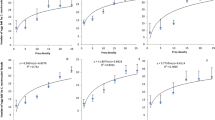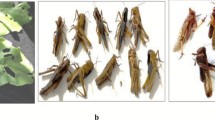Abstract
Acids found in moth scales of laboratory-rearedHeliothis zea (Boddie) moths are hexanoic, heptanoic, octanoic, nonanoic, 2- (or 3-) furan carboxylic, phenylacetic, benzoic, sorbic, and 4-hydroxybenzoic acid. The last two of these acids are preservatives added to the artifical diet as sorbic acid and methyl-p-hydroxybenzoate. FemaleTrichogramma pretiosum Riley exhibited increased rates of parasitization ofH. zea eggs in the presence of some of these compounds in laboratory experiments. Exposure to a mixture of all of these compounds did not increase parasitization, and the elimination of acids from the crude moth-scale extract did not reduce parasitization by the wasps.
Similar content being viewed by others
References
Burton, R.L. 1969. Mass rearing the corn earworm in the laboratory. USDA-ARS 33-134.8 pp.
Harrell, E.A., andPerkins, W.D. 1971. A centrifugal dust collector used in a laboratory vacuum system.J. Econ. Entomol. 64:1553–1554.
Hendry, L.B., Greany, P.D., andGill, R. J. 1973. Kairomone medicated host-findings behavior in the parasitic wasp,Orgilus lepidus.Entomol. Exp. Appl. 16:471–477.
Jones, R.L., Lewis, W.J., Beroza, M., Bierl, B.A., andSparks, A.N. 1973. Host-seeking stimulants (kairomones) for the egg parasiteTrichogramma evanescens.Environ. Entomol. 2:593–596.
Lewis, W.J., andRedlinger, L.M. 1969. Suitability of eggs of the almond moth,Cadra cautella, of various ages for parasitism byTrichogramma evanescens.Ann. Entomol. Soc. Am. 62:1482–1484.
Lewis, W.J. Jones, R.L., andSparks, A.N. 1972. A host-seeking stimulant for the egg parasite,Trichogramma evanescens: Its source and a demonstration of its laboratory and field activity.Ann. Entomol. Soc. Am. 65:1087–1089.
Lewis, W.J., Jones, R.L., Nordlund, D.A., andSparks, A.N. 1975a. Kairomones and their use for management of entomophagous insects. I. Evaluation for increasing rates of parasitization byTrichogramma spp.J. Chem. Ecol. 1:343–347.
Lewis, W.J., Jones, R.L., Nordlund, D.A., andGross, H.R., Jr. 1975b. Kairomones and their use for management of entomophagous insects: II. Mechanisms causing increase in the rate of parasitization byTrichogramma spp.J. Chem. Ecol. 1:349–360.
Oatman, E.R., Platner, G.R., andGonzalez, D. 1970. Reproductive differentiation ofTrichogramma pretiosum, T. semifumatum, T. minutum, and T. evanescens, with notes on the geographic distribution ofT. pretiosum in the southwestern United States and Mexico (Hymenoptera: Trichogrammatidae).Ann. Entomol. Soc. Am. 63:633–635.
Young, J.R.,Hamm, J.J.,Jones, R.L.,Perkins, W.D., andBurton, R.L. 1976. Development and maintenance of an improved laboratory colony of corn earworms. USDA-ARS-S-110. 4 pp.
Author information
Authors and Affiliations
Additional information
Lepidoptera: Noctuidae.
Hymenoptera: Trichogrammatidae.
In cooperation with the University of Georgia College of Agriculture Experiment Stations, Coastal Plain Station, Tifton, Georgia 31793.
Mention of a commercial or proprietary product in this paper does not constitute endorsement by the USDA.
Rights and permissions
About this article
Cite this article
Gueldner, R.C., Nordlund, D.A., Lewis, W.J. et al. Kairomones and their use for management of entomophagous insects. XV.. J Chem Ecol 10, 245–251 (1984). https://doi.org/10.1007/BF00987852
Revised:
Issue Date:
DOI: https://doi.org/10.1007/BF00987852




